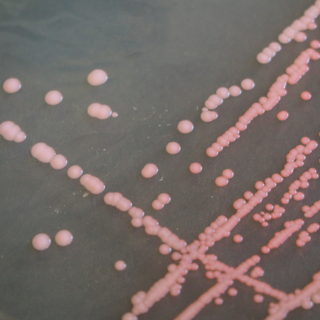The Aquificota phylum is a diverse collection of bacteria that live in harsh environmental settings. The name Aquificota was given to this phylum based on an early genus identified within this group, Aquifex, which is able to produce water by oxidizing hydrogen. They have been found in springs, pools, and oceans. They are autotrophs, and are the primary carbon fixers in their environments. These bacteria are Gram-negative, non-spore-forming rods. They are true bacteria as opposed to the other inhabitants of extreme environments, the Archaea.

Acidobacteriota is a phylum of Gram-negative bacteria. Its members are physiologically diverse and ubiquitous, especially in soils, but are under-represented in culture.
The Thermomicrobia is a group of thermophilic green non-sulfur bacteria. Based on species Thermomicrobium roseum and Sphaerobacter thermophilus, this bacteria class has the following description:

Sulfur-reducing bacteria are microorganisms able to reduce elemental sulfur (S0) to hydrogen sulfide (H2S). These microbes use inorganic sulfur compounds as electron acceptors to sustain several activities such as respiration, conserving energy and growth, in absence of oxygen. The final product of these processes, sulfide, has a considerable influence on the chemistry of the environment and, in addition, is used as electron donor for a large variety of microbial metabolisms. Several types of bacteria and many non-methanogenic archaea can reduce sulfur. Microbial sulfur reduction was already shown in early studies, which highlighted the first proof of S0 reduction in a vibrioid bacterium from mud, with sulfur as electron acceptor and H
2 as electron donor. The first pure cultured species of sulfur-reducing bacteria, Desulfuromonas acetoxidans, was discovered in 1976 and described by Pfennig Norbert and Biebel Hanno as an anaerobic sulfur-reducing and acetate-oxidizing bacterium, not able to reduce sulfate. Only few taxa are true sulfur-reducing bacteria, using sulfur reduction as the only or main catabolic reaction. Normally, they couple this reaction with the oxidation of acetate, succinate or other organic compounds. In general, sulfate-reducing bacteria are able to use both sulfate and elemental sulfur as electron acceptors. Thanks to its abundancy and thermodynamic stability, sulfate is the most studied electron acceptor for anaerobic respiration that involves sulfur compounds. Elemental sulfur, however, is very abundant and important, especially in deep-sea hydrothermal vents, hot springs and other extreme environments, making its isolation more difficult. Some bacteria – such as Proteus, Campylobacter, Pseudomonas and Salmonella – have the ability to reduce sulfur, but can also use oxygen and other terminal electron acceptors.

Venenivibrio stagnispumantis strain CP.B2 is the first microorganisms isolated from the terrestrial hot spring Champagne Pool in Waiotapu, New Zealand.

Bacterial phyla constitute the major lineages of the domain Bacteria. While the exact definition of a bacterial phylum is debated, a popular definition is that a bacterial phylum is a monophyletic lineage of bacteria whose 16S rRNA genes share a pairwise sequence identity of ~75% or less with those of the members of other bacterial phyla.
Deinobacterium is a genus in the Deinococcota phylum (Bacteria). Not to be confused with Deinobacter, a disused name for Deinococcus.
Armatimonadota is a phylum of gram-negative bacteria.
Geobacillus thermoglucosidasius is a thermophilic gram-positive bacterium, and a member of the Bacillota phylum. It was first isolated from soil in Japan in 1983.
Chthonomonas calidirosea is a Gram-negative bacterium and also the first representative of the new class Chthonomonadetes within the phylum Armatimonadota. The Armatimonadota were previously known as candidate phylum OP10. OP10 was composed solely of environmental 16S rRNA gene clone sequences prior to C. calidirosea's relative, Armatimonas rosea's discovery. It is now known that bacterial communities from geothermal environments, are generally constituted by, at least 5–10% of bacteria belonging to Armatimonadota.
Fimbriimonas ginsengisoli is a Gram-negative bacterium and the first representative of the class Fimbriimonadia within the phylum Armatimonadota. The Armatimonadota were previously known as candidate phylum OP10. OP10 was composed solely of environmental 16S rRNA gene clone sequences prior to F. ginsengisoli's relative, Armatimonas rosea's discovery.
Pedobacter ginsengisoli is a species of bacteria first isolated from a ginseng field, hence its name. It is Gram-negative, strictly aerobic, rod-shaped, non-motile and non-spore-forming bacterial strain with type strain Gsoil 104T.
Bryocella elongata is a bacterium, a type species of genus Bryocella. Cells are Gram-negative, non-motile pink-pigmented rods that multiply by normal cell division and form rosettes. The type strain is SN10(T). B. elongata was first isolated in 2011 from a methanotropic enrichment culture.
Dehalogenimonas lykanthroporepellens is an anaerobic, Gram-negative bacteria in the phylum Chloroflexota isolated from a Superfund site in Baton Rouge, Louisiana. It is useful in bioremediation for its ability to reductively dehalogenate chlorinated alkanes.
Marinitoga piezophila is a species of rod-shaped, thermo-piezophilic bacteria. It is, anaerobic, chemo-organotrophic, sulfur-reducing, motile, have a mean length of 1-1.5 micrometres and stains Gram-negative. The type strain is KA3T.
Lentisphera araneosa is a marine bacteria strain in the bacterial phylum Lentisphaerota. They are able to produce viscous transparent exopolymers and grow attached to each other by the polymer in a three-dimensional configuration. They are part of the natural surface bacterial population in the Atlantic and Pacific oceans. They are less than 1% of the total bacterial community. This species is gram negative, non-motile, non-pigmented, aerobic, chemoheterotrophic, and facultatively oligotrophic sphere-shaped. Its genome has been sequenced.
Xenophilus azovorans is a bacterium from the genus Xenophilus which has been isolated from soil in Switzerland.
Olivibacter ginsengisoli is a Gram-negative, aerobic, heterotrophic, rod-shaped, non-spore-forming and non-motile bacterium from the genus of Olivibacter which has been isolated from Korea.

Arthrobacter bussei is a pink-coloured, aerobic, coccus-shaped, Gram-stain-positive, oxidase-positive and catalase-positive bacterium isolated from cheese made of cow's milk. A. bussei is non-motile and does not form spores. Rod–coccus life cycle is not observed. Cells are 1.1–1.5 μm in diameter. On trypticase soy agar it forms pink-coloured, raised and round colonies, which are 1.0 mm in diameter after 5 days at 30 °C The genome of the strain A. bussei KR32T has been fully sequenced.




